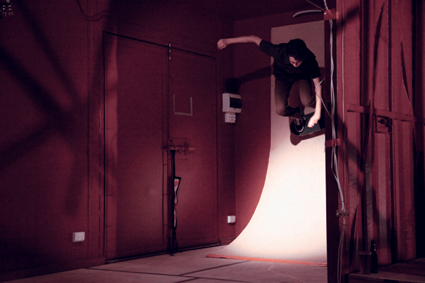skate, create, destroy
laetitia wilson: suspended motion, the bakery

Cameron Campbell, Suspended Motion
photo Pilar Mata Dupont
Cameron Campbell, Suspended Motion
OON THE CUSP OF THE COMMERCIAL CRACKDOWN ON SKATER CULTURE DURING THE EARLY 80S TWO SKATE MAGAZINES CHAMPIONED OPPOSING MOTTOS: ‘SKATE AND CREATE’ WAS PITTED AGAINST ‘SKATE AND DESTROY’ (SEE THRASHER MAGAZINE [1982] AND TRANSWORLD SKATEBOARDING [1983]). AS TWO ASPECTS OF CHAOS, THE DESTRUCTIVE AND THE CREATIVE ARE PRESENTED AND EXPLORED IN THE EXHIBITION SUSPENDED MOTION CURATED BY JAMES HENSBY AT ARTRAGE’S NEWLY REFURBISHED BAKERY COMPLEX.
These themes are not so much polarised but rather conjoined under the banner of ‘creative transgression.’ The exhibition offers a unique interpretation of the conjunction of art and skateboarding by diverging from the art genres generally associated with skate (street art, illustration and graphics), to deliver a contemporary cross-media display of design, installation, video, performance, sculpture, print, paint, kinetics and an accompanying publication of glorious creation and construction shots.
The opening night witnessed an excitable crowd enthusiastically drawn to artist Ben Barretto’s painting machine and performance. This piece had local skaters pull tricks back-and-forth within the shipping-container spaces of the Bakery and trigger the production of quasi-Modernist paintings. The machine was a sophisticated but also visually awkward contraption and amidst the crowds it was difficult to discern how the real-time action and raw presence of the skating prompted the movement and execution of the multicoloured wheel-like forms on canvas.
The physicality of skating was perhaps more directly communicated in the works displayed in the Black Box space. In Morgan Campbell’s piece, a bench sits alongside a video to bring the creative/destructive collusion to the fore. Violence in the action of skating is demonstrated in the repetition of surface damage; the denting, scratching, staining, scraping grind of not only the surfaces the skate-board hits, but the board itself. A stop-motion video displays the accumulation of paint from a bench transferred to the underside of a board alongside a video of the same board used to pull tricks on the bruised bench, which sits before the video with an air of well worn pathos.
On the opposite wall, a video by Cam Campbell traces the destructive effect of a board as it literally rips through sheets of paper. A ribbon of paper is messily splayed and bundled on the gallery floor and what resembles a loop of this paper is transformed into a ramp that dominates the corner of the room. Again, the evidence of action is present in the ramp’s scarred surface, the process of which can be witnessed on a monitor embedded in its cut-out core. This room has it all—props, documentation, traces of past actions, impact on the built environment, demonstration of tactical manoeuvring and sound to match. It also communicates the high degree of physicality inseparable from the act of skating. Movement is more remembered than suspended and tightly interconnected with materiality and context.
In the Bread Box gallery the works resonate more with abstraction and less with the rawness of the physical act of skating; they are about the conceptual, the minimal, form and design. Tom Muller’s mirrored plywood spine-ramp peaks like a Swiss Alp and recalls the mirrored effect familiar to classic skate videos. Unlike works in the previous room this piece is far removed from the grind of wheels, but it is also a tease because it is skateable. Skateability is then utterly banished in Jason Hansma’s sculpture which also reconfigures the aesthetic of skating through mirroring. It borrows the form and dimension of the ramp from the opening-night performance and reflects it to make a diamond shape. The surface of this shape is overlayed with slick black Perspex, its gleam clearly stating ‘don’t touch,’ its clean, reflective properties celebrated with a thin neon strip placed on the adjoining wall.
The video works in both rooms are distinct in their own right, but it is difficult to read them without being reminded of Shaun Gladwell’s classics, such as Kickflipping Flaneur (2000), where skating as creating is mesmeric and portrayed in conversation with art history. Like Gladwell’s works, the video pieces in the show operate on a different level from the familiar fast, choppy, fish-eyed aesthetic of many traditional skate videos. In continuity with the other works in the show, they meditate on the act of skating as creative and visually compelling, if not romantic, as well as rough and dirty. This re-emphasises the themes of destruction and creation which come together in Suspended Motion to culminate in what is ultimately a dynamic and original engagement of art and skateboarding.
Suspended Motion, curator James Hensby, artists Ben Barretto, Cameron Campbell, Morgan Campbell, Jason Hansma, James Hensby, Tom Muller; the Bakery, Breadbox Gallery, Oct 23-Nov 4
This article was originally published online Nov 22, 2010.
RealTime issue #100 Dec-Jan 2010 pg. web






